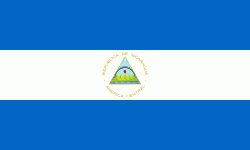Chinandega (Municipio de Chinandega)
Chinandega is a city and the departmental seat of Chinandega department in Nicaragua. It is also the administrative centre of the surrounding municipality of the same name. It is Nicaragua's 2nd most important city (economy) and 6th largest city, with a population of 114,417 (2021 estimate), and a total of 137,170 in the municipality. It is located about 134 km northwest of Managua and about 72 km southwest of El Guasaule, on the border with Honduras. Chinandega is situated about 20 km from the Pacific Ocean.
The city is served by Chinandega Airport.
The region around Chinandega produces agricultural products, particularly oil, flour, peanuts, shrimp, and sugarcane, and distilled liquors.
The city's weather is warm and humid due to its location at a low altitude in the tropics.
Located near the Nicaraguan border with Honduras, Chinandega sits on the CA-1 (Pan-American Highway). The department of Chinandega is 4929 km2 in area and has a population of 378,970 distributed among thirteen municipalities: Chinandega (department seat), El Viejo, Corinto, Chichigalpa, Posoltega, El Realejo, Puerto Morazán, Villanueva, Somotillo, Santo Tomás del Norte, San Juan de Cinco Pinos, San Pedro del Norte and San Francisco del Norte.
The department has numerous beaches, natural reserves, historic towns, mangroves, and ancient churches; the volcano of San Cristóbal, the highest in Nicaragua, can be found here, as well as the other volcanoes of the San Cristóbal complex (El Chonco, Moyotepe, and Casita), and further east, the peninsula-forming Cosigüina volcano.
Chinandega is a center of agriculture growing sugarcane, bananas, peanuts, sesame seeds, cashews, oranges, and grains. It is a shrimping and fishing center and it manufactures salt and leather goods. The city is also home to the largest sugar mills and rum factory (Flor de Caña) in the country.
Natives of the department include Salomón Ibarra Mayorga, writer of the national anthem of Nicaragua; Tino López Guerra, composer of "Rey del Corrido"; the priest Tomás Ruiz, and athletes Vicente Padilla and Próspero González.
The city is served by Chinandega Airport.
The region around Chinandega produces agricultural products, particularly oil, flour, peanuts, shrimp, and sugarcane, and distilled liquors.
The city's weather is warm and humid due to its location at a low altitude in the tropics.
Located near the Nicaraguan border with Honduras, Chinandega sits on the CA-1 (Pan-American Highway). The department of Chinandega is 4929 km2 in area and has a population of 378,970 distributed among thirteen municipalities: Chinandega (department seat), El Viejo, Corinto, Chichigalpa, Posoltega, El Realejo, Puerto Morazán, Villanueva, Somotillo, Santo Tomás del Norte, San Juan de Cinco Pinos, San Pedro del Norte and San Francisco del Norte.
The department has numerous beaches, natural reserves, historic towns, mangroves, and ancient churches; the volcano of San Cristóbal, the highest in Nicaragua, can be found here, as well as the other volcanoes of the San Cristóbal complex (El Chonco, Moyotepe, and Casita), and further east, the peninsula-forming Cosigüina volcano.
Chinandega is a center of agriculture growing sugarcane, bananas, peanuts, sesame seeds, cashews, oranges, and grains. It is a shrimping and fishing center and it manufactures salt and leather goods. The city is also home to the largest sugar mills and rum factory (Flor de Caña) in the country.
Natives of the department include Salomón Ibarra Mayorga, writer of the national anthem of Nicaragua; Tino López Guerra, composer of "Rey del Corrido"; the priest Tomás Ruiz, and athletes Vicente Padilla and Próspero González.
Map - Chinandega (Municipio de Chinandega)
Map
Country - Nicaragua
 |
 |
| Flag of Nicaragua | |
Originally inhabited by various indigenous cultures since ancient times, the region was conquered by the Spanish Empire in the 16th century. Nicaragua gained independence from Spain in 1821. The Mosquito Coast followed a different historical path, being colonized by the English in the 17th century and later coming under British rule. It became an autonomous territory of Nicaragua in 1860 and its northernmost part was transferred to Honduras in 1960. Since its independence, Nicaragua has undergone periods of political unrest, dictatorship, occupation and fiscal crisis, including the Nicaraguan Revolution of the 1960s and 1970s and the Contra War of the 1980s.
Currency / Language
| ISO | Currency | Symbol | Significant figures |
|---|---|---|---|
| NIO | Nicaraguan córdoba | C$ | 2 |
| ISO | Language |
|---|---|
| EN | English language |
| ES | Spanish language |















